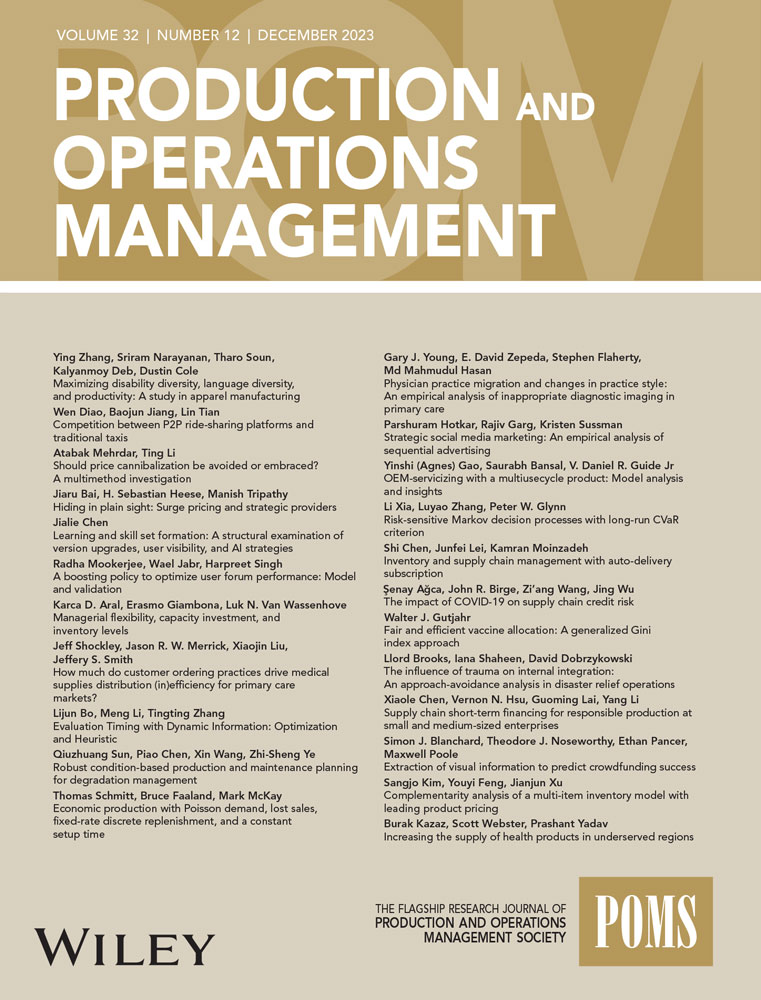库存和供应链管理与自动交付订阅
IF 5.1
3区 管理学
Q1 ENGINEERING, MANUFACTURING
引用次数: 0
摘要
自动交付是一种广泛应用于供应链的订购模式,即供应商根据买方选择的在预定日期交付的固定运输数量向买方(或多个买方)交付产品。买方享有自动送货订单的折扣和其他优惠,包括免费订阅和取消。由于这些利益似乎都是以供应商的成本为代价给买方带来的,因此供应商决定提供自动交付的基本原理及其对双方盈利能力的影响是一个有趣的问题。我们首先开发了一个由供应商和单个买家组成的模型,其中供应商为自动送货订单提供折扣,买方选择自动送货数量,并具有取消订购的灵活性。我们推导了双方库存系统的运行特征,并检验了他们的最优决策。我们的分析表明,买家从自动送货折扣中受益;供应商从需求扩张效应和库存减少效应中获益,这是自动交付单元成本的潜在折扣;供应链从减少牛鞭效应中受益。我们还发现,渠道协调要求供应商通过自动送货折扣将与库存相关的节省传递给买方,这取决于双方持有成本率的比率。此外,我们研究了一个模型的扩展,其中供应商宣布了一个可用于多个买家的折扣,我们表明,在指数需求下,供应商的最优自动交付折扣可以基于来自所有买家的总需求信息来确定。最后,我们讨论了另一种模型扩展,其中供应商的自动交付循环订单的提前期比常规订单的提前期更长,并对提前期差为一个时间段的情况进行了全面分析。本文章由计算机程序翻译,如有差异,请以英文原文为准。
Inventory and supply chain management with auto‐delivery subscription
Abstract Auto‐delivery is a subscription model widely employed in supply chains, whereby a supplier delivers products to a buyer (or multiple buyers) according to the buyer's choice of a constant shipping quantity to be delivered at prescheduled dates. The buyer enjoys a discount for the auto‐delivery orders and other benefits, including free subscription and cancellation. Because these benefits seem to all accrue to the buyer at the supplier's expense, the rationale for the supplier's decision to offer auto‐delivery and its impact on the profitability of both parties is an intriguing concern. We first develop a model that consists of a supplier and a single buyer, whereby the supplier offers a discount for the auto‐delivery orders and the buyer chooses the auto‐delivery quantity with the flexibility of cancelling the subscription. We derive the two parties' operating characteristics of their inventory systems and examine their optimal decisions. Our analysis shows that buyers benefit from the auto‐delivery discount; the supplier benefits from the demand‐expansion effect and the inventory‐reduction effect, a potential discount on the cost of the auto‐delivery units; and the supply chain benefits from reducing the bullwhip effect. We also find that channel coordination requires the supplier to pass the inventory‐related savings to the buyer through the auto‐delivery discount, which depends on the ratio of the two parties' holding cost rates. Moreover, we examine a model extension whereby the supplier announces a discount that is available for multiple buyers, we show that the supplier's optimal auto‐delivery discount under exponential demand can be determined based on the aggregate‐level demand information from all buyers. Finally, we discuss another model extension whereby the lead time of the supplier's recurring orders for auto‐delivery is longer than that of the regular orders and present a full analysis of the case when the lead time differential is one time period.
求助全文
通过发布文献求助,成功后即可免费获取论文全文。
去求助
来源期刊

Production and Operations Management
管理科学-工程:制造
CiteScore
7.50
自引率
16.00%
发文量
278
审稿时长
24 months
期刊介绍:
The mission of Production and Operations Management is to serve as the flagship research journal in operations management in manufacturing and services. The journal publishes scientific research into the problems, interest, and concerns of managers who manage product and process design, operations, and supply chains. It covers all topics in product and process design, operations, and supply chain management and welcomes papers using any research paradigm.
 求助内容:
求助内容: 应助结果提醒方式:
应助结果提醒方式:


